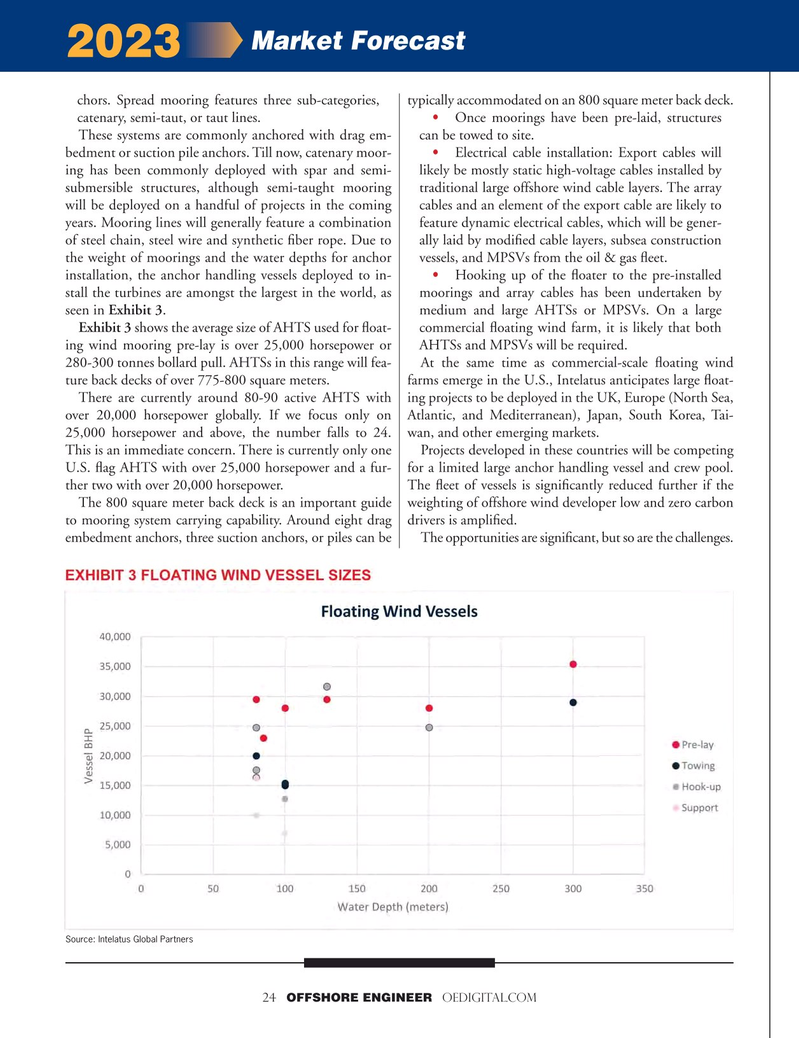
Page 24: of Offshore Engineer Magazine (Nov/Dec 2022)
Read this page in Pdf, Flash or Html5 edition of Nov/Dec 2022 Offshore Engineer Magazine
Market Forecast 2023 chors. Spread mooring features three sub-categories, typically accommodated on an 800 square meter back deck.
catenary, semi-taut, or taut lines. Once moorings have been pre-laid, structures UÊ
These systems are commonly anchored with drag em- can be towed to site. bedment or suction pile anchors. Till now, catenary moor- Electrical cable installation: Export cables will
UÊ ing has been commonly deployed with spar and semi- likely be mostly static high-voltage cables installed by submersible structures, although semi-taught mooring traditional large offshore wind cable layers. The array will be deployed on a handful of projects in the coming cables and an element of the export cable are likely to years. Mooring lines will generally feature a combination feature dynamic electrical cables, which will be gener- of steel chain, steel wire and synthetic ?ber rope. Due to ally laid by modi?ed cable layers, subsea construction the weight of moorings and the water depths for anchor vessels, and MPSVs from the oil & gas ?eet.
UÊ installation, the anchor handling vessels deployed to in- Hooking up of the ?oater to the pre-installed stall the turbines are amongst the largest in the world, as moorings and array cables has been undertaken by seen in Exhibit 3. medium and large AHTSs or MPSVs. On a large
Exhibit 3 shows the average size of AHTS used for ?oat- commercial ?oating wind farm, it is likely that both ing wind mooring pre-lay is over 25,000 horsepower or AHTSs and MPSVs will be required.
280-300 tonnes bollard pull. AHTSs in this range will fea- At the same time as commercial-scale ?oating wind ture back decks of over 775-800 square meters. farms emerge in the U.S., Intelatus anticipates large ?oat-
There are currently around 80-90 active AHTS with ing projects to be deployed in the UK, Europe (North Sea, over 20,000 horsepower globally. If we focus only on Atlantic, and Mediterranean), Japan, South Korea, Tai- 25,000 horsepower and above, the number falls to 24. wan, and other emerging markets.
This is an immediate concern. There is currently only one Projects developed in these countries will be competing
U.S. ?ag AHTS with over 25,000 horsepower and a fur- for a limited large anchor handling vessel and crew pool. ther two with over 20,000 horsepower. The ?eet of vessels is signi?cantly reduced further if the
The 800 square meter back deck is an important guide weighting of offshore wind developer low and zero carbon to mooring system carrying capability. Around eight drag drivers is ampli?ed.
embedment anchors, three suction anchors, or piles can be The opportunities are signi?cant, but so are the challenges.
Source: Intelatus Global Partners 24 OFFSHORE ENGINEER OEDIGITAL.COM

 23
23

 25
25